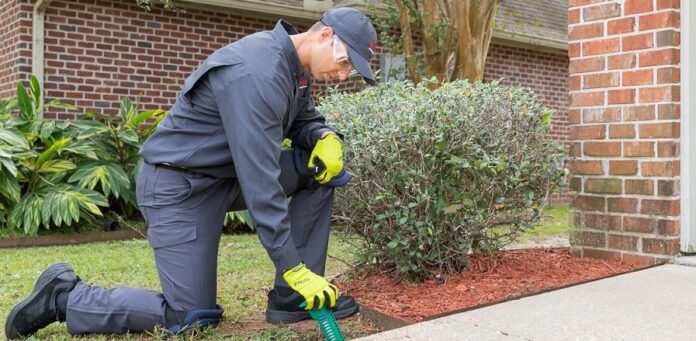You’ve hired a local pest control operator, but it’s not time to breathe a sigh of relief yet. First, before they arrive, there are a few things you need to do to get your home and property ready for extermination services.
Preparation isn’t hard, but it can make the difference in the overall outcome of the services.
Homeowners who take steps to prepare their homes for pest control are more likely to get a good outcome, have safe results, and see longer-lasting pest removal. In some cases, exterminators may not be able to work in homes and areas that aren’t ready for them, so you definitely want to follow their instructions and take additional steps.
1. Do exactly what your pest control company advises.
Most pest control contractors will give you a list of specific steps to take before they arrive. These lists vary depending on the type of pest present or being treated against, the location and severity of the infestation, the chemicals and products being used, and other factors. If your contractor hasn’t given you specific directions, ask them what you should do before they arrive.
2. Clean before your exterminator arrives.
It might sound counterintuitive to clean before and after pest control services, but the treatments will be more effective with fewer items in homes, including the removal of trash, debris, and extra items. Pests can hide in boxes, laundry, trash, and other areas, and sprayed or fogged chemicals can adhere to items. To learn more, you can read this post about preparing your house for pest control services. It can also be hard for pest control technicians to effectively apply treatments if they need to work around extra items. The cleaner and less cluttered your home, the better result you’re likely to get.
If you see dead insects or pests, eggs, droppings, or other evidence of pests, make sure to remove them and clean the areas before the pest control operator arrives. You should also replace vacuum bags and thoroughly sanitize any equipment used to remove or clean up pests or their eggs or droppings, as these items can cause re-infestation.
3. Make sure there’s easy access to the area(s) to be treated.
Most pest control companies won’t move furniture or appliances or other items. This means that it’s up to you to pull large furniture, appliances, and other items away from walls and out from corners so that the workers can be sure to get pest control chemicals everywhere necessary. Many pests hang out along walls and in corners because they see those areas as relatively safe, so you’ll want to be sure the treatment is able to reach those areas.
4. Remove or safely store unnecessary items from each room to be treated.
Clothing, toys, bedding, furniture, toiletries, pet beds, and other items should be removed from rooms, stowed in cabinets, carefully wrapped in plastic, or placed in washable bins. Chemicals can absorb into fabrics and other soft surfaces, so your long-term health and safety depends on you carefully preparing each room. If you place items in cupboards or
drawers, you may want to seal door cracks with packing tape or another type of plastic or cellophane sealant. Paper tape like masking tape can absorb and transmit chemicals.
Items like toothbrushes, toiletries, and similar should be removed from bathrooms and rooms that will be sprayed. Chemicals can get into toothpaste, floss, soaps, and other items and pose a poisoning risk.
If your home is infested with bed bugs, termites, fleas, or similar pests, you may need to empty out wooden furniture like bookcases and storage items. Wood furniture or furniture containing wood should not be covered; talk with your contractor about how to prepare for this type of pest control.
5. Safely store food items and food preparation tools and appliances
If you’re dealing with a kitchen pest infestation, your pest control contractor may need to spray inside your kitchen cabinets. This will require you to remove everything from cabinets, countertops, and the rest of your kitchen. In this case, you may also be asked to throw out all food that’s in bags or boxes as pests can access those items and may lay eggs or be hiding in crevices or materials. Even cans and jars may need to be thrown away or sanitized to prevent reinfestation.
Open food and drink can become contaminated with pest control chemicals, and that can be harmful or deadly to humans and pets. If your kitchen is not being thoroughly treated and you can keep items in cabinets and other areas, all open food should be sealed and safely stored in a refrigerator, freezer, cupboard, or sealed storage container. Utensils, silverware, plates and cups, pans, and food processing appliances including mixers and blenders should be removed from the kitchen or carefully stored to avoid possible contamination of food products even after the treatment is complete.
6. Protect houseplants and sensitive items.
Plants can absorb pest control chemicals and may die or become sick. If possible, move plants to a garage, balcony, or porch where they won’t be near the pest control solution application. Large, immovable plants can be covered with plastic. If moving plants outside, be wary of leaving them in sunny areas where they may become scorched or sunburned, and watch for possible infestation of outside insects that may hitch a ride back into your home on the plants or in the soil.
7. Take your pets to a safe location.
Pest control is by definition a toxic process. Even safer and more eco-friendly pest control solutions are meant to kill and deter living things. So it’s vital that you take steps to protect any household pets, including cats, dogs, rodents like hamsters and guinea pigs, fish, and others. If possible, take your pet to a neighbor, friend, or family member’s home for the duration of the treatment and even a day or two after. If fish are in large aquariums and can’t be moved, cover the aquarium tightly with plastic and turn off any air pumps that pull in outside air. Use an autofeeder for the duration of the pest control treatment.
Remove all pet beds, bowls, toys, food, leashes, and other items from your home or store them in plastic or washable bins. Chemicals can linger on these items and cause illness or other problems.
8. Final preparations:
After you’ve done everything above, there are a few other things you can do to make the process more effective and safe.
- Take out all trash and remove trash bags and liners from garbage cans.
- Clean off countertops, removing appliances, paper towel holders, and other items.
- Remove or cover water filters, water outlets on refrigerators, and similar items.
- Clean out and leave empty sinks in kitchens and bathrooms.
- Safely store refrigerated and frozen foods so the refrigerator can be unplugged and pulled away from the wall.
- Open curtains and close all windows.
- Art, antiques, and other sensitive or expensive items should be removed or carefully stored in plastic to avoid chemical damage.
- Plan to stay out of your home for at least three hours, or as long as your pest control company suggests. If you’re sensitive to chemicals, you may want to wait 4-5 hours before coming back home. If anyone in the household has breathing problems, asthma, emphysema, or a history of allergic reactions to chemicals, avoid the home or treated areas for 24 hours or more. Talk to your contractor about the specific recommendations they have for you regarding how long to wait after treatment.
- If you have birds, fish, or sensitive pets, discuss with your veterinarian specific ways to protect your pet before, during, and after the pest control treatments.
- Talk with your pest control operator about prevention strategies. Repairing holes and entry points for rodents and insects, carefully storing pet food and pantry items, moving wood piles close to the home, trimming bushes and foliage, sealing up attic spaces, sealing around the entry holes for pipes and wires, regularly applying tick and flea treatment to pets, and taking similar steps can prevent reinfestation and limit the chemical treatments your home needs in the future. And that’s better for you and the environment.





















